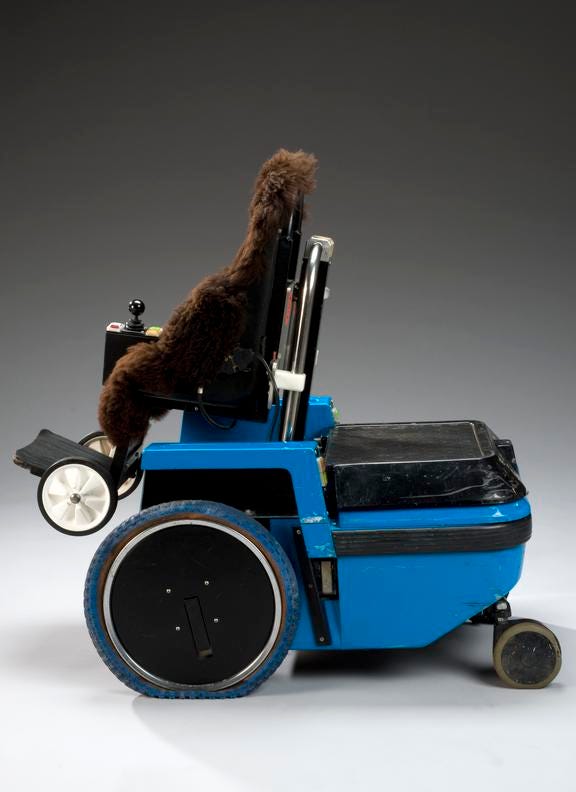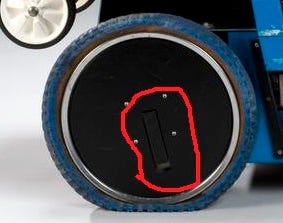The Turbo Mark VI, I’ll begin and end with the good
I have fond memories of this chair. Let’s start with its positive attributes. It was made for children and made with the natural tendencies of children in mind, mostly. Mine was red and did not have such a fancy seat cover, the image above is of one currently housed in a museum in the UK. That’s where the chair was designed and manufactured. For its time, it was definitely a great feat of simplistic engineering.
Prior to receiving this wheelchair my personal mobility was relegated to three essential methods. My favorite was “scooting,” a method of sitting on my butt, planting my hands, and pushing backwards. I would continue to do this because of this chair and I’ll get to that in a minute. Blocks, matchbox cars, Legos, and other such toys kept me very happily occupied on the floor. Of course, as you found out in a previous post, I also loved being on the ground outdoors. The next best method of locomotion for me was, sadly, a baby stroller that my parents would push me around in. I remember my mother taking me for long walks on rural roads for years. It was obviously easier to transport a stroller than this wheelchair, but that severely limited my natural childlike desire to explore. Exploration is an extremely important part of childhood learning and development. As I aged that stroller became humiliating for obvious reasons; I wasn’t a baby despite being small enough to fit in a stroller. The last method of getting around was to be carried by a parent or other person familiar with how to do so safely. This could be terrifying because I understood the fragility of my skeleton due to my severe Osteogenesis Imperfecta diagnosis. It could also be equally as humiliating as the stroller, especially with other kids around.
This chair came with a sense of freedom that I’d never before experienced. I’m told that the first thing I did with it was run over the feet of my father and the therapist. I was instantly transformed from a weak, fragile being into a hazard to others! It was great. The Turbo expanded my ability to explore the yard and even facilitated better inclusion for beginning Head Start. Our first accessible vehicle was an old suburban that my father built a slide out plywood ramp to the back of. I could drive the chair up and into the back, be secured, and transported to Head Start. With this chair I was able to go on the ginger bread man walk, a fun story like adventure around town-independently. When we first brought that chair home my childhood friend at the time pointed and exclaimed to her mother: “Look! I told you he’d be able to walk one day!” A wheelchair is, essentially, a replacement for working and ambulatory legs and in todays market for such I find it sad that this seems to have been forgotten.
The best feature of this model? Look at the wheels on the leg-rest that seem to be far above the ground. They’re there to allow that leg-rest to become an escape! The seat could lower, the wheels would hit the floor or ground, and the leg-rest would pivot and become a sort of ramp from which I could exit. Not only did I find more mobility in the chair, but I didn’t lose my precious access to the floor where I could create my own world with the toys I mentioned earlier. I gained without losing!
The bad, I’ve endured much worse in newer models
The Human Interface Device(HID), which you might call a control or joystick, was not the least bit water proof. I was four years old. You don’t have to think too hard to imagine what could happen. You might imagine any kid would spill a drink, but imagine a country kid outside? Once from a little rain, and again from a light garden hose spray(it’s very likely that I sprayed myself), the HID got wet. For me, understanding my fragility on top of being a very young kid, these events were terrifying. The water caused the chair to operate itself without any control by me, the user. Even the seat that went down and up would go on its own accord.
For the technology available at the time, this isn’t too terrible or all that solvable of a problem in the grand scheme. This chair sincerely changed my life for the better by facilitating both my exploration and my schooling. I became the first person using a wheelchair to start and finish school in my district. School will come up again in the next part.
The ugly, and again I’ve experienced worse since
Let’s discuss the design feature that was actually a design flaw. In the red circle of the above image you can see a lever. That lever was an instant attach or release function for the main drive wheel. Remember, the purpose of a child’s wheelchair is exploration and socializing with other children. Children are curious, and it is not their fault that they push buttons and pull levers - many toys aimed at improving their learning and exploration have them. Kids are both naturally inclined to pull levers and furthermore trained to do so.
To make the “other kids problem” worse regarding this “feature” when I entered kindergarten one of the first things staff did was instruct my class to never pull the lever. If you’ve ever dealt with a child, let alone twenty of them as a group, you instantly understand the mistake. Like myself most kids have an integrated mindset to explore, push boundaries, and break rules. It’s a part of the natural learning process so I do not blame whoever did the following.
As you have likely imagined by now, someone pulled the lever. The wheel fell off, the chassis dropped to the floor on one side, and I was immobilized. Even worse for my specific situation, that drop was enough to fracture my femur. I screamed in pain, I reacted with fear, and once realization of what happened kicked in I instantly felt wounded emotionally. How could I build trust not knowing who pulled it, why they pulled it, and knowing they were instructed both to not and why to not? Today, however, I wonder if who did it remembers doing it and how they must feel looking back on that memory. It cannot be good. Both of us would arguably be damaged by this incident, which repeated. Twice this happened.
More importantly though, your legs cant be so easily taken away by another. Your mobility, if you’re ambulatory, is relatively secure. Imagine if a small child could easily render you stranded? How secure in life could you feel? Kids need to feel secure.
Back to the good, this was a great chair
For it’s time this chair was amazing. I gained greater access to my world, greater ability to learn, grow, and experience life, and despite the issues greater confidence in navigating the world. I wouldn’t be as “me” without it. I like me. It is with extreme gratitude that I remember this chair and what it did for my life and my development. Future chairs would definitely not leave me with the same feelings. Today’s models are largely garbage in my humble 36 years of experience based opinion. Not because they aren’t better than what we had in the 1980’s but because compared to the tech surrounding us we could do so much better.
This is why I’ve found The Mobility Independence Foundation, a 501c3 non-profit organization primarily aimed at improving this realm of tech. With existing tech we’re improving the reparability, maintainability, and supply chain aspects of long term use machines and we can change the entire world for millions to come.



